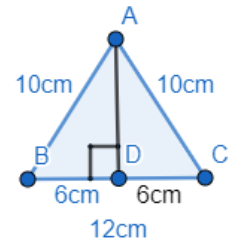
What is the area of an isosceles triangle with two equal sides of 10cm and a base of 12cm?
Answer
514.8k+ views
Hint: An isosceles triangle has two sides equal. The area of a triangle is given as $\dfrac{1}{2}\times b\times h$ , where b is the base length, and h is the height of the triangle as shown in the figure below. We can use the fact that the perpendicular to the base of the triangle equally divides the base and hence we can use the Pythagoras theorem to find the height and hence the area of the triangle.

Complete step-by-step solution:
Let us assume the given triangle to be triangle ABC as shown in the figure. AB and AC are the equal sides with length 10cm each and the base BC with length 12cm. If we drop a perpendicular from A to BC, for an isosceles triangle we know that this perpendicular will divide the base equally into two parts. Hence, BD and DC are equal to 6cm.
We know that triangle ABD is a right angled triangle. Hence we can apply Pythagoras theorem to find length of AD. We get,
$\begin{align}
& \,\,\,\,\,\,\,A{{B}^{2}}=A{{D}^{2}}+B{{D}^{2}} \\
& \Rightarrow A{{D}^{2}}=A{{B}^{2}}-B{{D}^{2}} \\
& \Rightarrow A{{D}^{2}}={{10}^{2}}-{{6}^{2}} \\
& \Rightarrow A{{D}^{2}}=64 \\
& \,\,\Rightarrow AD=8 \\
\end{align}$
Therefore, we get AD=8cm. Now, let us use this to find the area of the triangle. It is given as,
$A=\dfrac{1}{2}\times b\times h$
We are given base length as 12cm and we gave found height as 8cm, hence by substituting these values, we get,
$\begin{align}
& \,\,\,\,\,\,\,A=\dfrac{1}{2}\times 12\times 8 \\
& \Rightarrow A=48 \\
\end{align}$
Therefore, the area of the triangle is found to be $48c{{m}^{2}}$.
Note: Another way to find the area of an isosceles triangle is by using the formula, $A=\dfrac{1}{2}\times AB\times BC \times \sin \left( \alpha \right)$ , where we know AB is 10cm and BC is 12cm, we need to find $\sin \left( \alpha \right)$ , where $\alpha $ is the angle between AB and BC as shown in the figure below.

Complete step-by-step solution:
Let us assume the given triangle to be triangle ABC as shown in the figure. AB and AC are the equal sides with length 10cm each and the base BC with length 12cm. If we drop a perpendicular from A to BC, for an isosceles triangle we know that this perpendicular will divide the base equally into two parts. Hence, BD and DC are equal to 6cm.
We know that triangle ABD is a right angled triangle. Hence we can apply Pythagoras theorem to find length of AD. We get,
$\begin{align}
& \,\,\,\,\,\,\,A{{B}^{2}}=A{{D}^{2}}+B{{D}^{2}} \\
& \Rightarrow A{{D}^{2}}=A{{B}^{2}}-B{{D}^{2}} \\
& \Rightarrow A{{D}^{2}}={{10}^{2}}-{{6}^{2}} \\
& \Rightarrow A{{D}^{2}}=64 \\
& \,\,\Rightarrow AD=8 \\
\end{align}$
Therefore, we get AD=8cm. Now, let us use this to find the area of the triangle. It is given as,
$A=\dfrac{1}{2}\times b\times h$
We are given base length as 12cm and we gave found height as 8cm, hence by substituting these values, we get,
$\begin{align}
& \,\,\,\,\,\,\,A=\dfrac{1}{2}\times 12\times 8 \\
& \Rightarrow A=48 \\
\end{align}$
Therefore, the area of the triangle is found to be $48c{{m}^{2}}$.
Note: Another way to find the area of an isosceles triangle is by using the formula, $A=\dfrac{1}{2}\times AB\times BC \times \sin \left( \alpha \right)$ , where we know AB is 10cm and BC is 12cm, we need to find $\sin \left( \alpha \right)$ , where $\alpha $ is the angle between AB and BC as shown in the figure below.
Recently Updated Pages
Two men on either side of the cliff 90m height observe class 10 maths CBSE

What happens to glucose which enters nephron along class 10 biology CBSE

Cutting of the Chinese melon means A The business and class 10 social science CBSE

Write a dialogue with at least ten utterances between class 10 english CBSE

Show an aquatic food chain using the following organisms class 10 biology CBSE

A circle is inscribed in an equilateral triangle and class 10 maths CBSE

Trending doubts
Why is there a time difference of about 5 hours between class 10 social science CBSE

Write a letter to the principal requesting him to grant class 10 english CBSE

What is the median of the first 10 natural numbers class 10 maths CBSE

The Equation xxx + 2 is Satisfied when x is Equal to Class 10 Maths

Which of the following does not have a fundamental class 10 physics CBSE

State and prove converse of BPT Basic Proportionality class 10 maths CBSE




